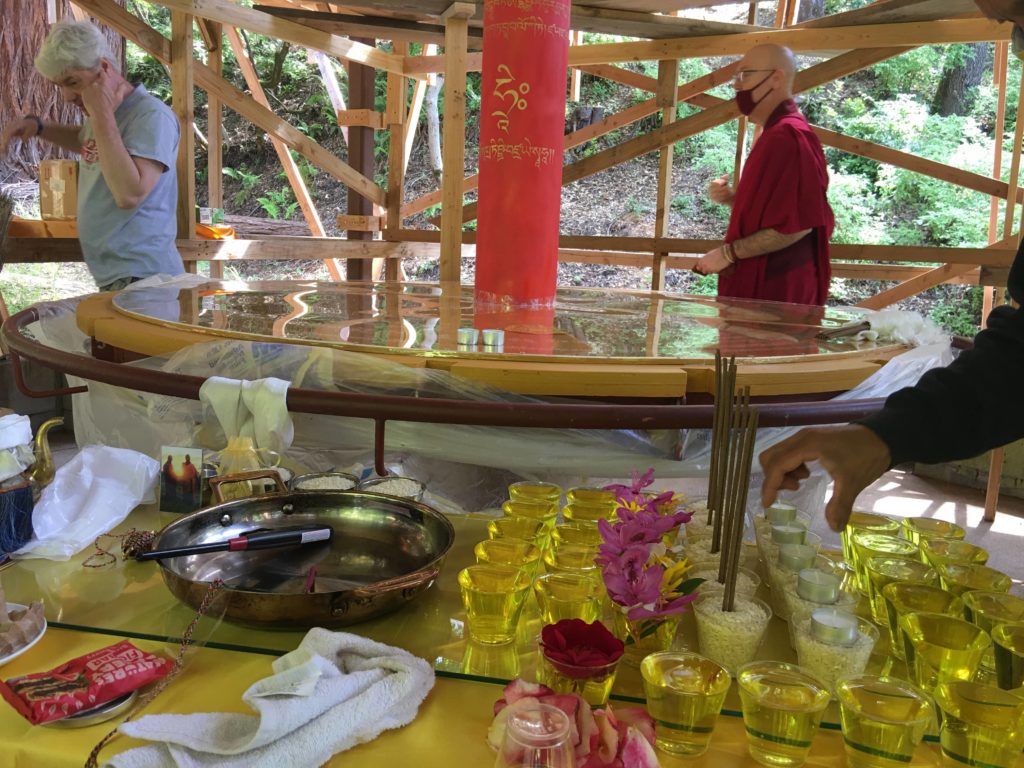
Remembering Age
REMEMBERING Åge DELBANCO
By Francesca Hampton
March 21, 2021
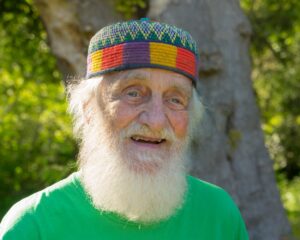 Darkness went to God and said, “Please help me.
Darkness went to God and said, “Please help me.
Light is chasing me. Everywhere I dwell, I never have peace.”
“I shall talk to him,” said God. And God called on Light and said,
“Why are you chasing Darkness, so he never has peace?”
“I am not chasing Darkness,” said Light.
“How can I chase him? I have never seen Darkness.”
Facebook entry by Åge Delbanco, Winter 2020, author unknown
How little we really know of the lives of even those we call friends. In my multi-day effort to learn more about the life of old friend and one-time Vajrapani resident Åge Delbanco for this retrospective, I have found myself continually astonished at the breadth and depth of the tapestry of life Åge created – only fragments of which I knew before. His peaceful death at home at the age 95 has left a gap in the lives of literally hundreds of friends, students and admirers around the world. The art he left – from insightful portraits to giant scroll paintings that need a truck to transport, to elegant pottery to transcriptions of Indian ragas, recordings and a book of intricate African drum patterns, not to mention a published translation of Taoist literature, and a collection of art incorporating Nordic runes – is now treasured in homes and centers all over world. The wisdom he shared and the model of life he showed, will affect countless others for decades to come. I was moved most of all by the utterly authentic way Åge found to live, deploying all his talents to the fullest, following his curiosity everywhere it took him, loving all and finding delight in every person and every experience that came to him.
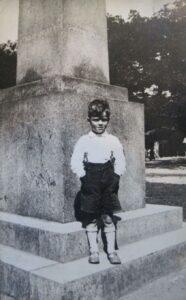 Åge’s childhood is mostly unknown to his friends. He spoke of it positively, but it must have held some challenges. He was born in Denmark in 1925, on the eve of the worldwide Great Depression, to a brilliant mother who was the first female lecturer at the Polytechnic Institute in Copenhagen. His father was a well-known Danish painter, and surely passed some of those artistic genes to his new son. Yet Åge’s parents never lived together as a couple, and his father had no presence in his life. When Åge was only 14, the Nazi occupation of Denmark began and he later shared an early memory of the Danish government’s many efforts to save the lives of its Jewish citizens. In the midst of the war, when Åge was only 16, his mother passed away. She left her only son to the care of one of her many sisters. By the time WWII ended, Åge was 19 years old, completing his education in Copenhagen, where he earned a degree in Civil Engineering and studied architecture.
Åge’s childhood is mostly unknown to his friends. He spoke of it positively, but it must have held some challenges. He was born in Denmark in 1925, on the eve of the worldwide Great Depression, to a brilliant mother who was the first female lecturer at the Polytechnic Institute in Copenhagen. His father was a well-known Danish painter, and surely passed some of those artistic genes to his new son. Yet Åge’s parents never lived together as a couple, and his father had no presence in his life. When Åge was only 14, the Nazi occupation of Denmark began and he later shared an early memory of the Danish government’s many efforts to save the lives of its Jewish citizens. In the midst of the war, when Åge was only 16, his mother passed away. She left her only son to the care of one of her many sisters. By the time WWII ended, Åge was 19 years old, completing his education in Copenhagen, where he earned a degree in Civil Engineering and studied architecture.
Åge’s life in Denmark as a young adult seems to have been a time of gradual self-discovery. He began working professionally as a civil engineer In Copenhagen and tried to come to terms with the difficulties of being a gay man in the fifties. He moved into the first of many cooperative living communities and his true life began. It was here he began to work in earnest as an artist and even opened and ran a co-op art gallery with fellow community members. He also discovered a delight in hashish and began to visit Morocco on a regular basis, eventually leaving his engineering life behind altogether. According to friend Peter Kedge, Åge proudly claimed to have been “the original freak” as well as the first to have smuggled hash from Morocco to Denmark.
For several years he traveled between Morocco and France and Denmark, living in communes, supporting himself with hundreds of portraits of both tourists and the Moroccan well-to-do. Some of these colorful pictures remain in his collection. He was also painting dramatic abstracts. He began to wear his signature jelaba, an elegant turban and a beard. (When he made an effort later at Kopan to try life clean-shaven, even Lama Yeshe objected. “Don’t ever cut it off again!”) He suffered at least one torturous month in a Moroccan prison, after generously offering a hashish pipe to a policeman. His aunt was finally able to pay the fine to get him home.
Back in Denmark, the pivotal next chapter of of his life began. Danish “travelers,” backpackers who had made the long trek to India and back, had appeared in his commune, full of tales. Åge longed to go, but first waited to gather a small group of friends before he went. At last, with five others, one a baby, he set out overland, slowly crossing Afghanistan and Pakistan, and found his way briefly to the feet of a swami in New Delhi who was teaching other Danes. Here, his money running low, and his visa expiring, Åge learned he could exit and re-enter via Nepal to renew his visa. But it was in Nepal that his life was to intersect with the men who would change it forever, Lamas Thubten Yeshe and Thubten Zopa Rinpoche.
Staying near the Boudhanath stupa outside Kathmandu, Åge saw a little hill at a distance. It “called to him” he reported in an interview for Mandala Magazine. He went up for a walk but found no one there. He sat and watched the sun set. Soon after, he left for a trek in the Himalayas and ran into Bhagavan Das – a westerner, and future teacher of Ram Dass – who was on his own six-year journey of spiritual discovery, dressed as a sadhu in a loin cloth. Bhagavan Das advised him to go back to Kopan, and soon enough Åge realized this “Kopan” was the same hill he had just explored. On this second visit, he met Zina Rachevsky who convinced him to stay longer, even offering him a room he came to love, the money he needed, and help renewing his visas. She also bestowed on him the name “Babaji” since he was dressed like a sadhu when he arrived. The year was 1969. He was 44 years old. 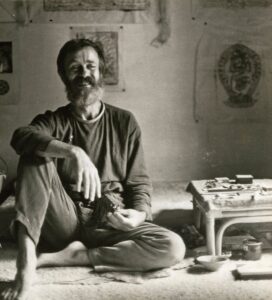
“Then the Lamas came,” Åge reported in the interview for Mandala, “ and it was just fantastic because they were there with us. You could talk to them whenever you needed to because there were not that many people around. (At first) I had a hard time relating (the teachings) to my life and it was more when Lama Yeshe started giving teachings on Sunday in English that it became clear to me that they did concern me.” He stayed until 1973, attending the annual lam-rim courses and contributing his architectural and engineering skills to the construction of the first gompa there. He also studied and truly mastered the exacting art of painting Buddhist thankas. He even asked to be ordained as so many were doing then, but was told, “Better wait.”
“Lama Yeshe knew me better than I knew myself,” Åge laughed in his interview.
Åge returned to Europe for the mid-70s, He lived for a time with jazz player Don Cherry, for jazz was another of his passions, but his Buddhist connections continued to shape his life. When Lama Yeshe gave his first teachings outside Nepal, Åge was drafted to help. Judith Weitzner, who first met him then, recounts “There he was in Switzerland In a caftan and turban behind the wheel of a Deux Cheveux, basically a clown car, driving the lamas to and fro, so sweet and kind. For me, it was love at first sight.” By the late 70s, Åge was restless again and decided to move to America, trying out first New York and then Berkeley. He landed at last at Vajrapani Institute In the hills above Santa Cruz in the center’s second year of existence. Here he built his own small house in the foerest and then helped master carpenter John Jackson design the plans for the large two-story gompa. He later again served as Lama Yeshe’s personal attendant for three months in his house in Aptos and even cooked once for the Dalai Lama. For 13 years he remained as the center’s artist-in-residence. On request, he created thanka after thanka, incorporating classic imagery with uniquely customized details. Steve Pearl’s treasured Vajrayogini, for example, contains Milarepa emerging from his cave. And quite often Vajrapani’s land made up the background.
The bonds he formed with Vajrapani’s founding members created lifetime friendships. He was the only man, Janet Brooke reports, who came to the women’s day gatherings. “When Geshe Dhargyey came,” she laughs, “he was even brave enough to play the King in Princess Peach, Rainbow Fairy.” He worked with Janet on a statue of Buddha, and it was Åge’s image, the kindest of sages, she used as a model for Asita in her illustrations for a book on Buddha’s life with Jon Landaw. When Lama Yeshe had passed, it was Åge’s drawings that decorated the stupa that held his remains, and even now, after his own passing, the proceeds from the sale of many of his artworks will go to fund the giant prayer wheel being built at Vajrapani.
After 13 years at this Buddhist center, Åge was spending more and more time in Santa Cruz. It was here he had gotten his first thrilling taste of African drumming and little by little began to bond with members of the drumming community. Eventually, he moved down to Santa Cruz and made African drums a full-time passion. In the 90’s he even made several months-long trips to Africa, visiting villages in Guinea, Ghana, Burkina Faso, and Senegal. There he lived with local people and studied with master teachers and helped some of them gain visas to teach in America. He learned so much that he wrote and published a work called The Book of West African Rhythms. “Åge was a brilliant man,” says Vajrapani friend Tom Waggoner. “Everything he did in life he did fully and excellently.” For years, he labored to transcribe the Taoist classic, the Tao de Ching, and then searched persistently until he found a publisher. The result in 1988 was Lao Zi, The Book of the Way and Virtue: Translation and Commentary by Yeshe Palden. (Åge’s Tibetan name). He also transcribed Indian ragas and played them with Tom on an instrument similar to an Indian sarod.
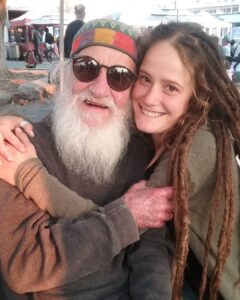 Back in Santa Cruz, reports his drumming friend Eli, Åge began regularly attending rainbow gatherings every July throughout the United States and was a key founder of Dunun Village, a drumming enclave at the gatherings that eventually expanded to be its own festival twice a year. For a wide circle of young people he truly became “Baba”, their African grandfather, a man who taught them not only drumming but also wisdom, drawn from Buddhist and African and Taoist traditions, as well as his own wealth of lived experience. “He always had a kind listening ear for young people,” Wanda Sisnroy remembers. “They reverenced him,” Tom says. “They saw him as a wisdom being.” Over 200 people came to honor his 80th birthday celebration. Five beautiful dakinis with fire wands tied to each of their fingers danced in the street before him. For an hour, people stood to pay tribute with tears in their eyes. And this extraordinary birthday gathering eventually became an annual event. “Who else of us at Vajrapani,” Tom marveled, “can say that?” Even Lama Osel went to drum with Åge in Santa Cruz.
Back in Santa Cruz, reports his drumming friend Eli, Åge began regularly attending rainbow gatherings every July throughout the United States and was a key founder of Dunun Village, a drumming enclave at the gatherings that eventually expanded to be its own festival twice a year. For a wide circle of young people he truly became “Baba”, their African grandfather, a man who taught them not only drumming but also wisdom, drawn from Buddhist and African and Taoist traditions, as well as his own wealth of lived experience. “He always had a kind listening ear for young people,” Wanda Sisnroy remembers. “They reverenced him,” Tom says. “They saw him as a wisdom being.” Over 200 people came to honor his 80th birthday celebration. Five beautiful dakinis with fire wands tied to each of their fingers danced in the street before him. For an hour, people stood to pay tribute with tears in their eyes. And this extraordinary birthday gathering eventually became an annual event. “Who else of us at Vajrapani,” Tom marveled, “can say that?” Even Lama Osel went to drum with Åge in Santa Cruz.
Life is expensive in coastal California, yet Åge somehow continued to live in a way very few of us manage – he never allowed his life to become bisected into work life and real life. “Åge had a sense of frugality and good taste that was quite magical put together.” Tom Waggoner reports. He rode his bicycle to Staff of Life until he was 92 and purchased only the best quality tea, for example. “There was nothing he loved more, said his long-term friend Eli, than to invite a friend over “for a long talk on philosophy and death and hope over some marijuana and a full pot of good tea.”
To support himself in Santa Cruz, Åge also took up pottery. In the late 80’s he took a course at Cabrillo College and then another. Soon he was part of a community of potters called Clay Creations. He produced and sold over 1500 elegant, unique pieces at the weekly farmers’ market in Santa Cruz and other events. In his last years he returned to his Norse roots to make a study of Runes, painting them onto banners and scrolls and incorporating them into his pottery and painting, spelling out words that mattered most to him, such as the name of the Dalai Lama and “Shambhala.”
At the Åge of 93, Åge suffered his first health scare after a fall, followed by dehydration that caused confusion. Up to that point his mind had remained almost untouched by the faintest cloud of dementia. When the confusion cleared and he started joking again his friends were immensely relieved. He resisted help and hospitals, and evaded the guard rails put in for him by Tom, but his heart began to show signs of atrial fibrillation and his marvelous energy and fit body began to fail. In 2020, the terrible year of Covid, when young friends avoided him to keep him safe, he suffered from loneliness and isolation for the first time reports his friend Eli, even though friends like Janet Brooke and Tom and Jon Landaw and Truus took him out as often as they could. In the last week of his life, however, his younger friends were able to return. With hospice minding necessary medications, and his community’s loving visits, he was able to pass peacefully at the end of his long and immensely fortunate life. On February 19, 2021 he was in his own room, surrounded by love, while Lama Zopa in Nepal was doing special meditation practices for him, and his dear friends, Tom Waggoner and Eli Chance, were at his bedside, reading aloud the texts Lama Zopa recommended they recite for him. His passing occurred during the auspicious days of Tibetan New Year when all good karmic actions are greatly enhanced. In facebook posts, Lama Zopa has sent out requests to those who loved him all over the world to pray for his good rebirth.
- You taught me so much, Åge. Foremost, how to live life like it isn’t over. Puja Chance
- A beautiful being who created families wherever he went. He was loved in all his incarnations. Elaine Jackson
- I hold so much gratitude for the friendship we shared. The deep conversations. Good food. Amazing jazz shows. An awe inspiring multi-faceted artist. He is truly a talented and unique spirit. His memory will forever shine on in our hearts. Melissa Cara
- Rest in peace dear Åge. You have been an inspiration to me and so many others. You will be greatly missed!! Jessa Kay Cruz
- A true angel took flight tonight. Forever in our hearts, your inspiration will live on through us. May our every beat echo your beautiful vibrations, Åge. Marilyn Hatfield

